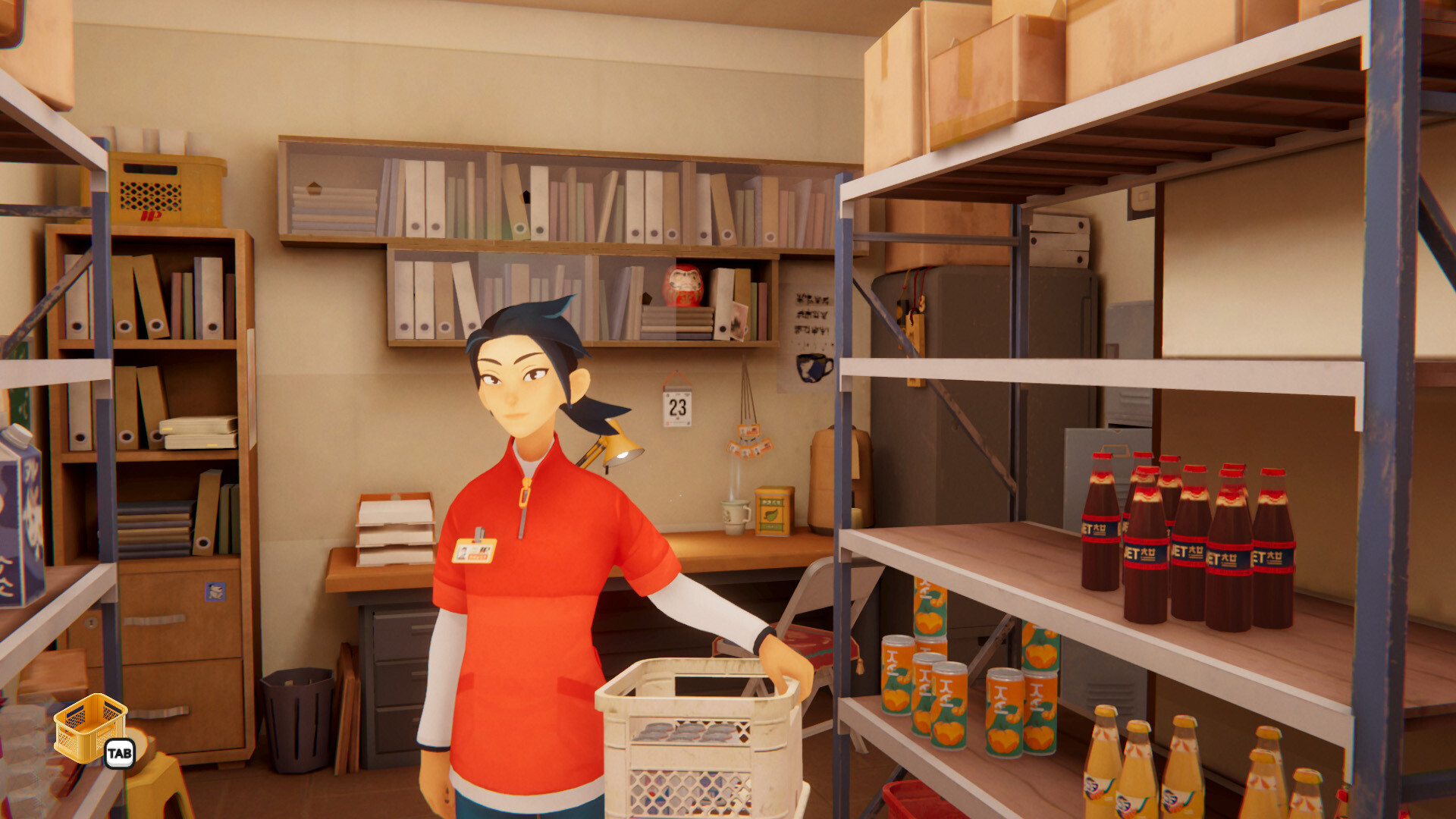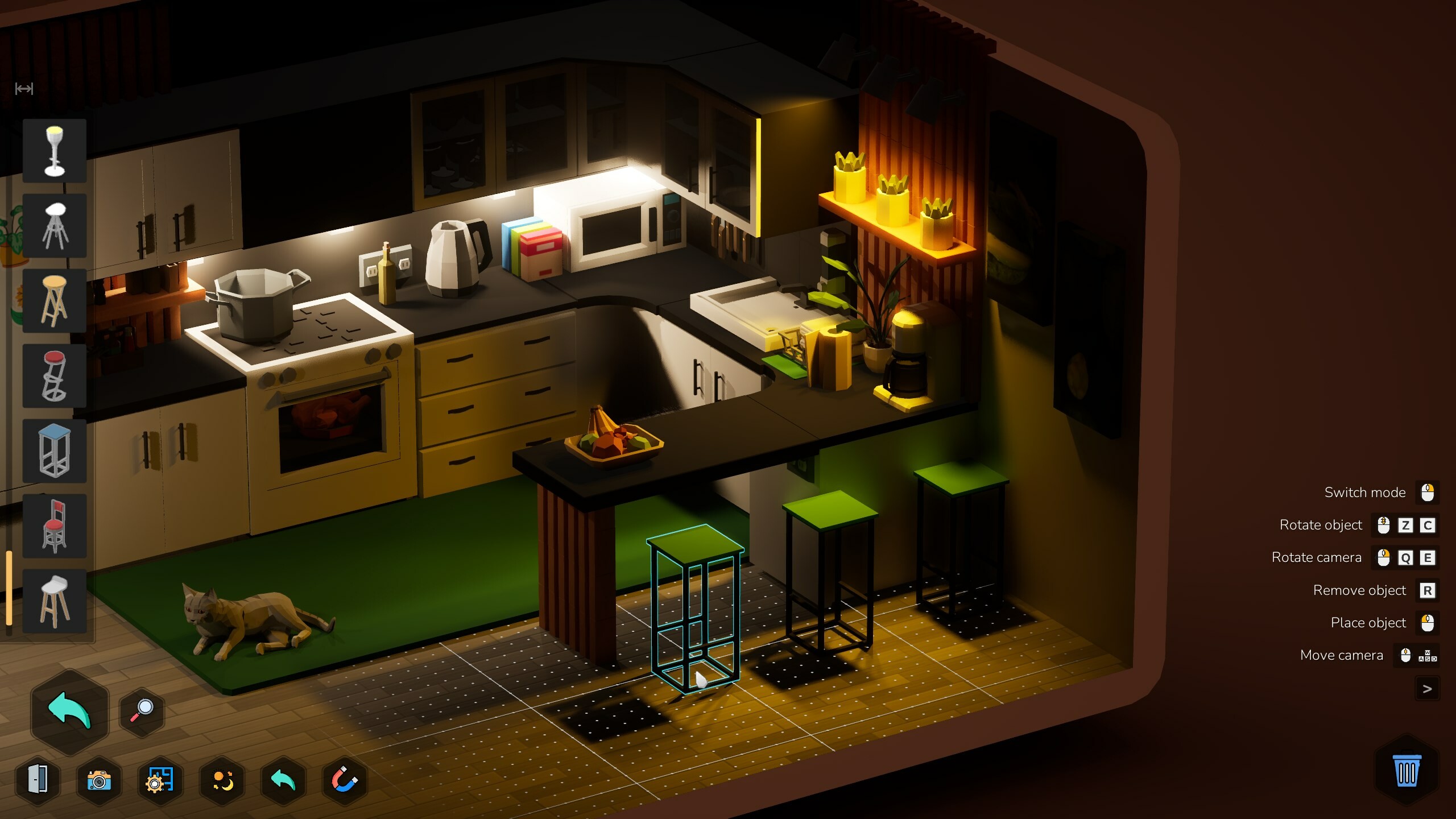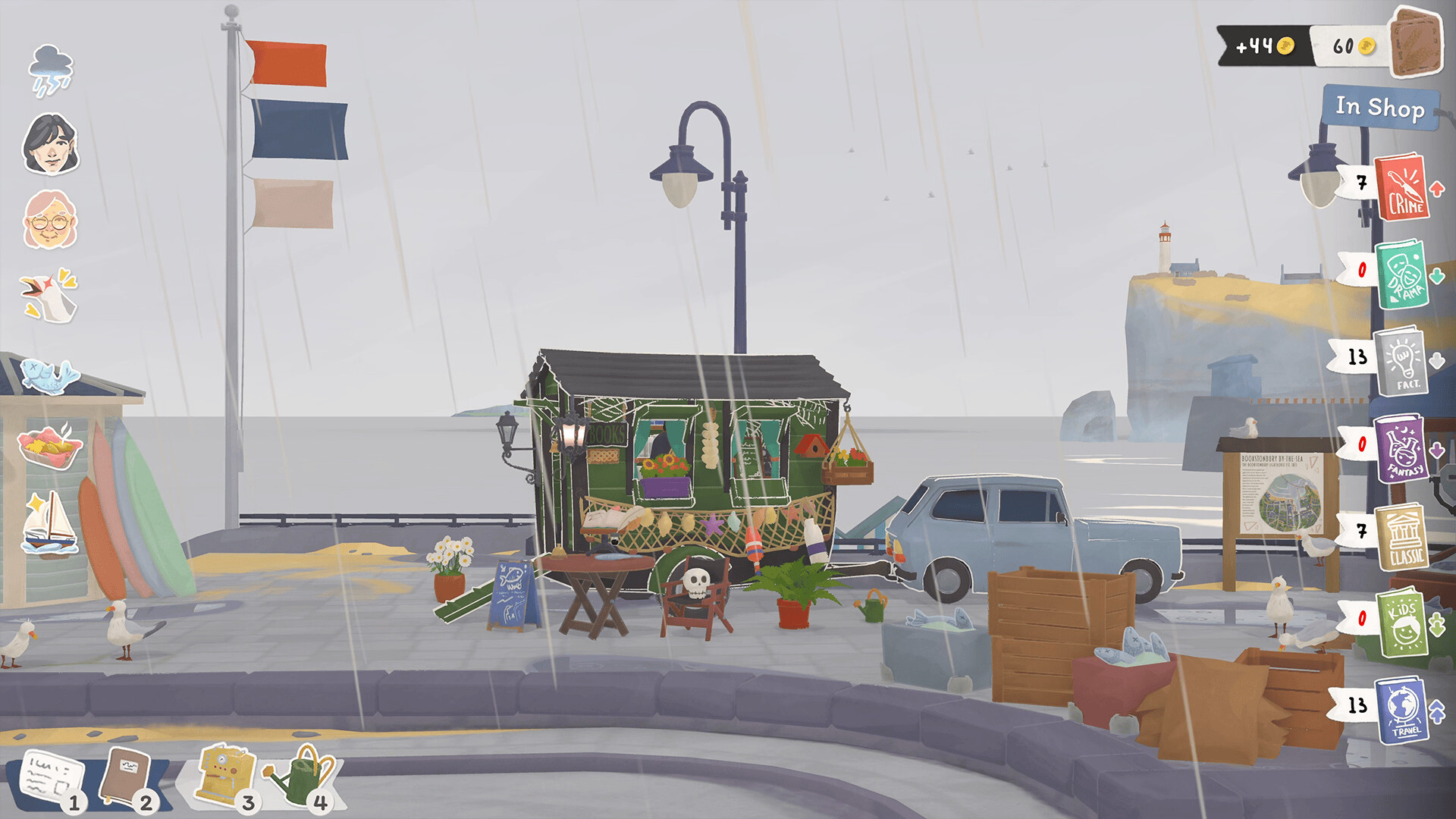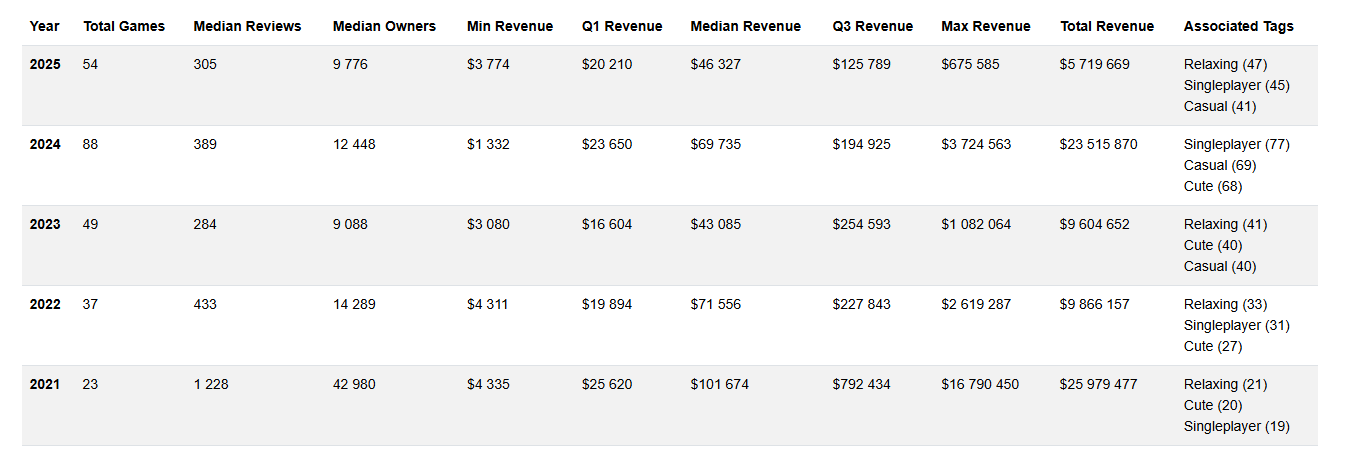Roundtable on Cozy Games: Specifics, Challenges, and Prospects
In recent years, there's been a noticeable trend towards cozy games: more and more projects under the "cozy" tag have been released on Steam each year. What exactly is this trend, and is it worth pursuing in game development? We discussed with Alexander Blintsov, Dmitry Muratov, and Kirill Oreshkin.
According to Steam Trender, in 2024, twice as many cozy games were released on Steam compared to 2023. In the first eight months of 2025, nearly as many cozy games were released as in all of 2024.
Trend in the release of games with the cozy tag by year (Steam Trender)
Currently, there are 1,419 games with the cozy tag on Steam. Among them are notable titles like Sky: Children of the Light, Tiny Glade, Tiny Bookshop, and Little Kitty Big City.
1. Let's start with the basics. Is there a clear universal understanding in the market of what qualifies as a cozy game?
Alexander Blintsov — head of his own studio, author of Furnish Master
Not quite. In communities, I notice that people define this concept somewhat differently for themselves. There have even been disputes about it in marketing communities ("Steam Publish", HTMAG). Some define it by the visual aspect, others by genre. For instance, some might consider Stray a cozy game, even though it doesn't visually fit the bill, while other players might categorize rather hardcore games as cozy simply because they look "cozy," including games like the reissue of Dwarf Fortress or RimWorld.
However, when you look at the cozy tag on Steam, it leans more towards pleasant, soft, and stylized graphics, with the games themselves being not at all hardcore. Characters tend to look cute, the graphics aren't too contrasting, and they're mostly light-colored. Sometimes, they aren't games in the traditional sense, like Tiny Glade or our Furnish Master, where players simply enjoy the process of creating digital scenes.
Tiny Glade
Dmitry Muratov — Head of Publishing — Skystone Games, publisher of Tiny Bookshop
Yes, certainly. From pastel colors to age ratings and inclusivity, there are many criteria that scream cozy, but usually, it's about games where you engage in everyday activities. Cleaning, cooking, organizing items, taking photos, selling books, caring for animals.
Kirill Oreshkin — Co-founder — Polden Publishing, publisher of Train Valley Origins
In the market — definitely not. People constantly argue, debate — is this cozy or not? Is it a casual game or cozy? Is there horror-cozy? And so on.
Almost everyone thinks they have an obvious understanding of what cozy is, yet they can't agree among themselves.
2. How do you personally determine whether a game qualifies as cozy?
Alexander Blintsov — head of his own studio, author of Furnish Master
As a developer, I tend to define cozy by the visual style and overall "vibe" of the project. How cute and cozy it looks, whether it appeals to a wide age range, what feelings it evokes. It's worth mentioning that the game's difficulty or genre doesn't significantly matter. Even a shooter can be cozy if it's not about killing, for example, Splatoon.
As a player, I perceive the cozy category differently, focusing on my subjective preferences. If the game has pleasant graphics, lacks violence, is suitable for anyone to play, and gives me warm feelings, I might call it cozy. For instance, No Man’s Sky fits this category for me, although from a developer's perspective, I wouldn't classify it as cozy.
I assume many players do something similar — distinguish between the generally accepted and the personal. When marketing a game, this should also be considered, noting that what might seem cozy to one player could be off-putting to another. For example, overly girly and "cutesy" characters might not appeal to a male audience who still enjoy games like Stardew Valley.
Stardew Valley
Dmitry Muratov — Head of Publishing — Skystone Games, publisher of Tiny Bookshop
If it feels like the game is made with love (like grandma's soup!), maintains a color palette, is kind, non-violent, and easy to learn, then I’m almost inclined to classify it under the casual/cozy direction.
If, on top of all that, there are cats and dogs, harvesting, and exploring wild paths, then it’s likely cozy regardless of other tags that might be attached.
Kirill Oreshkin — Co-founder — Polden Publishing, publisher of Train Valley Origins
If the game looks cute and creates a sense of coziness, calm, and tranquility, I see it as cozy. In cozy games, you shouldn’t feel tense, you’re not in a rush, and you’re not overcoming great challenges. You spend time at a relaxed pace, finding joy and comfort in the style and visuals.
When I look at a game and see that nothing in its gameplay is stressing me out and that its atmosphere is sweet, then I recognize it as cozy.
We've dabbled in it a little, but many friends are working in the cozy category. I keep an eye on their progress.
3. Can cozy be considered the new casual?
Alexander Blintsov — head of his own studio, author of Furnish Master
I think that’s fair to say, especially considering that the target audience, and the games themselves, often lean towards casualness. A considerable portion of players for these games are not hardcore gamers or play only occasionally.
However, as I mentioned above, some games in this category cannot be considered casual. So it’s not quite right to equate these terms. Just as a casual game might not be cozy, a cozy game might not be very casual either.
Dmitry Muratov — Head of Publishing — Skystone Games, publisher of Tiny Bookshop
Judging by Steam alone, the cozy direction almost always goes hand in hand with casual. Therefore, I consider it the new "casual," but only within the PC and console sectors. The mobile niche has its own understanding of what casual is, despite some cozy PC projects, like Stardew Valley, being ported to mobile platforms.
Kirill Oreshkin — Co-founder — Polden Publishing, publisher of Train Valley Origins
I wouldn't say that. I believe all cozy games are casual, but not all casual games are cozy.
Practically any modern indie sim is casual: turn off your brain, sell in the store. But if the store in your game isn't cozy, then it’s not cozy.
A rough example. Supermarket Sim is a casual project but isn't cozy. InKonbini is cozy.
InKonbini: One Store, Many Stories
4. How much in demand are these projects among the Steam audience? Do they easily accumulate wishlists?
Alexander Blintsov — head of his own studio, author of Furnish Master
Even though it’s a niche category of games, it has a clear and considerable audience. Recently, more cozy games have been making it to the top charts. There's definitely demand for these games, though not as much as for some more hardcore and mass-market PC categories.
As for wishlists, there are challenges. On the one hand, this audience is quite loyal; however, as I've noticed, many players don't engage well with the platform itself. They might not be as eager to log into Steam to add something, then return months later to purchase the game. But I can confidently say that well-made cozy games with captivating trailers and other creative aspects do quite well with wishlists. Some games can gain 100,000 wishlists or more without massive marketing budgets.
Ultimately, it depends on the game. For instance, in Furnish Master, some users purchased the game to try out room designs before a renovation or move. They hadn’t used Steam before and hadn’t added it to their wishlist.
Furnish Master
Dmitry Muratov — Head of Publishing — Skystone Games, publisher of Tiny Bookshop
These games easily gather wishlists but converting those into sales is more challenging. Each time players see such a game, they're eager to add it to their wishlist, but when it comes to purchasing, the enthusiasm isn't always there. Sometimes games in this genre with a decent number of wishlists (over 100,000) still struggle to earn substantial revenue.
Kirill Oreshkin — Co-founder — Polden Publishing, publisher of Train Valley Origins
Yes, it seems there's currently a trend for cozy games. Many of them easily accumulate a lot of wishlists. It's common for relatively simple projects to grab 50-100 thousand wishlists quite effortlessly.
There are plenty of festivals on Steam with lots of traffic, and cozy games tend to perform well in those.
5. I've heard that a major issue with cozy games is poor wishlist-to-purchase conversion; what could be causing this, and is it true?
Alexander Blintsov — head of his own studio, author of Furnish Master
Unfortunately, I don’t have specific statistics, but I don't believe that's always the case. It's possible that the percentage of games with worse conversions is higher than in some other categories. However, I've talked to developers who have released cozy games and they've reported fair conversions.
Dmitry Muratov — Head of Publishing — Skystone Games, publisher of Tiny Bookshop
To understand why they sell poorly, one needs to understand why they’re easily added to wishlists but aren’t bought as readily: there's a lot happening in the world that impacts everyone. People want to escape these problems and get lost in games. At first glance, cozy games seem like the perfect solution. However, when it comes to purchasing, economic factors come into play: "Should I buy a big AAA title with hundreds of hours on sale or an indie game with possibly only 3-4 hours of content?"
Often, AA and other major games on the balance scale outweigh. They have more hype, more streamers. So, while someone might consider a cozy game as the best therapy, they're not always ready to spend money on it yet. Each major success in the cozy market strengthens the indie industry and the genre.
Kirill Oreshkin — Co-founder — Polden Publishing, publisher of Train Valley Origins
Yes, it's true that sales at release aren't as brisk as wishlist numbers. We even thought that all cozy games were cursed at one point. But Tiny Bookshop proved otherwise, and we no longer think that way.
However, we've seen many examples where cozy games didn't catch on. There could be many reasons — maybe the mechanics were too simple, or there wasn't enough content, or pricing issues. I can’t give a definitive answer.
Tiny Bookshop
6. Is there potential to profit from cozy games? What can they peak at earnings-wise?
Alexander Blintsov — head of his own studio, author of Furnish Master
There is. Again, you can check the cozy category on Steam and see the approximate earnings of these games. Revenue can reach tens of millions of dollars or more. With almost no AAA-games in the niche to skew statistics with massive budgets, this helps in analysis.
Revenue statistics for games with the cozy tag by year (Steam Trender)
The only caveat: in the cozy niche on PC, you’re unlikely to compete for the same revenue levels as other popular categories. Unlike mobile games, where the potential audience is much larger, here they might not suffice to have sales tails on par with hits from more hardcore genres like shooters or co-op games. There are exceptions, but hoping to be one isn't a great business strategy. It’s best to account for realistic revenue limits that you can achieve in advance.
Dmitry Muratov — Head of Publishing — Skystone Games, publisher of Tiny Bookshop
If a cozy game finds its audience, it can earn millions. Just recently, I oversaw the launch of Tiny Bookshop, which sold 220,000 copies in the first seven days at a $20 price point. Its primary market was the U.S. and the EU. I believe that sales of Tiny Glade are gradually nearing two million copies. If your cozy game gets featured at a Nintendo event, success is almost assured.
Kirill Oreshkin — Co-founder — Polden Publishing, publisher of Train Valley Origins
Even without hitting it big, cozy can earn hundreds of thousands of dollars, which is excellent for indie developers without publishers.
With publishers, you need to be earning millions. And here, you need to delve deeper into the subject to understand what's needed in the genre.
7. What about competition among cozy titles? Does it exist, considering that this niche accommodates games from entirely different genres?
Alexander Blintsov — head of his own studio, author of Furnish Master
Cozy isn't really a genre or a specific niche, so we can't talk about competition among similar titles in a narrow sense. It’s like saying there’s competition within game development itself. It depends on the kind of game you’re making. If it’s a visual novel, then yes, competition will be significantly higher than if you were creating an economic strategy game with a cozy aspect.
Dmitry Muratov — Head of Publishing — Skystone Games, publisher of Tiny Bookshop
There’s intense competition for attention on Steam. There's nothing new to say: year after year, there are more games, and solo developers are releasing them more frequently since learning various engines has become significantly easier. On the same day, we saw four other cozy games being released.
One of the few ways to alleviate this a bit is to create bundles with competitors post-release, sharing traffic while gaining visibility. Especially advantageous if your visibility is less than theirs.
Kirill Oreshkin — Co-founder — Polden Publishing, publisher of Train Valley Origins
It seems there's still plenty of space for creativity and developing diverse games. I don’t think dealing with fierce competition is the key challenge in developing cozy games.
8. What problems in the cozy games niche would you highlight?
Alexander Blintsov — head of his own studio, author of Furnish Master
I believe the most challenging part is balancing the game's style, difficulty, genre, UX, and controls. If you’ve never developed such games, it might be hard to hit the mark. Creating pleasant graphics and shading without overdoing the game's simplicity/complexity, while ensuring players aren’t frustrated by the controls or interface, can be tricky. I've often seen players complain about inconvenient cozy games. This ruins the perception. A game, contrary to its visuals and atmosphere, stops being seen as cozy. Achieving balance in all aspects can be challenging if your team lacks members who understand the audience for such games.
Another aspect not to forget is platforms. Many cozy gamers prefer playing wrapped in a blanket on a bed with a SteamDeck, so it’s wise to consider gamepad support and interface optimization for smaller screens. Our game also has a relatively high percentage of Mac users (6%). Moreover, cozy games fit beautifully on the Nintendo Switch, so if your game succeeds, I would consider porting it. Additionally, pay attention to minimum system requirements. Since cozy games are generally more casual, the target audience's hardware is likely less advanced.
In terms of marketing, it’s essential to follow tried-and-true methods as in other areas:
- Create a captivating trailer that correctly targets your audience;
- Beautifully and charmingly design your Steam page;
- Engage with the community, considering its characteristics and preferences;
- Build up wishlists.
Among the challenges, I’d highlight that on some platforms, like Reddit, there aren't many places to advertise your game. But with cunning and the right approach, the list of promotional channels can be significantly expanded.
Dmitry Muratov — Head of Publishing — Skystone Games, publisher of Tiny Bookshop
We’ve already discussed the oversaturation in the market, now let's talk about genre fatigue. Cozy isn’t a gameplay genre per se; it's more of a stylistic direction, so it's crucial what gameplay you attach to it. Farm simulator? Castle-building simulator? Apartment renovation?
If you can attach something new and unique, like a Japanese goods store as in InKonbini: One Store, Many Stories, or a castle generator like in Tiny Glade, it’s likely to attract players.
9. Should one pursue cozy projects?
Alexander Blintsov — head of his own studio, author of Furnish Master
If you understand this direction and want to pursue it, you can give it a try. Should you? That's for you to decide. This question can be posed for any direction with the same intent, and you'll get the same answer (except for overly risky genres).
Dmitry Muratov — Head of Publishing — Skystone Games, publisher of Tiny Bookshop
Despite the challenges, cozy remains extremely popular, boasts a vast audience in its niche, and can even sell better on Switch than on Steam.
My advice, which isn’t aimed at large studios and publishers, is to create what you genuinely care about.
Cozy games are rarely a business case. Enthusiasts usually create a game about what they love, and it turns out there are plenty of players waiting for something similar.
Still, if the goal is to make (some) money, perhaps it's simpler to delve into easy, yet effective genres like survivor-like or automation.
Kirill Oreshkin — Co-founder — Polden Publishing, publisher of Train Valley Origins
If cozy is something that resonates with you and you want to create something cozy, then go ahead. I'd suggest trying to make a cozy cooperative game, if possible. In co-op, the chances of wishlists converting to sales are significantly higher.










